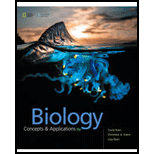
Concept explainers
Introduction:
The rotation of the earth around the sun is in an elliptical path. The Earth axis is not perpendicular to this plane of ellipse and is tilted at an angle of 23o. This results in changes in daylight, temperature and seasons in different parts around the earth. Summer season occurs when the Northern Hemisphere of the earth is tilted fully towards the sun.
Answer to Problem 1SA
Correct Answer:
The Northern Hemisphere of the earth is tilted mostly towards the sun in the summer season. Hence, correct answer is option b.
Explanation of Solution
Reasons for correct answer:
Summer season is a result of the tilted Northern Hemisphere mostly towards the sun. This makes the Northern Hemisphere to receive more sunlight, and increase in day light. In June, the Northern Hemisphere tilts towards the sun, receiving direct sunlight, resulting in more daylight than the Southern Hemisphere, which is away from the sun.
Hence, option b is correct.
Reasons for incorrect answer:
Option a. is given as, “spring.”
The Northern Hemisphere of the earth is tilted mostly towards the sun in the summer season not in spring. Hence, option a. is incorrect.
Option c. is given as “autumn”
Spring and autumn are results of moving of Northern Hemisphere away from the sun, but not completely towards the sun. Seasonal variations occur due to the tilting of the earth, rotation of the earth and its revolution around the sun. Spring and autumn do not result when Northern Hemisphere tilts mostly towards the sun. Hence option c. is incorrect.
Option d. is given as “winter”
When the Northern Hemisphere experiences winter, it will be tilted away from the sun, but not near. So option d is incorrect.
Hence options a., c., and d. are incorrect
Summer season occurs in the Northern Hemisphere due to its maximum tilting towards the sun. Thus, correct option is b.
Want to see more full solutions like this?
Chapter 43 Solutions
BIOLOGY:CONCEPTS+APPL.(LOOSELEAF)
- Using quail and chick embryos, quail-specific antibody and fluorescent tissue-specific antibodies, design an experiment where you investigate the tissues the cranial neural crest can give rise to. What are four derivatives of the cranial neural crest that you expect to see in the resulting chimeric embryos?arrow_forwardDoes the neural crest have to undergo epithelial to mesenchymal transition prior to migration through the developing embryo? Does the neural crest differentiate into different cell types based on their axial position along the anterior and posterior axis?arrow_forwardUsing quail and chicken embryos, what kind of experiment would you conduct to test if rib forming somites have their axial identity specified before segmentation? How do we know this phenotype is due to axial identity being specified before segmentation and not due to our experimental method?arrow_forward
- 8. Aerobic respiration of a 5 mM solution of tripeptide that is composed of the following three amino acids; alanine, leucine and isoleucine. Alanine breaks down to pyruvate, leucine breaks down to Acetyl-CoA and isoleucine breaks down to succinyl-CoA. Alanine NADH FADH2 OP ATP SLP ATP Total ATP Leucine Isoleucine Totals Show your work using dimensional analysis here: 4arrow_forward9. Aerobic respiration of one lipid molecule. The lipid is composed of one glycerol molecule connected to two fatty acid tails. One fatty acid is 12 carbons long and the other fatty acid is 18 carbons long in the figure below. Use the information below to determine how much ATP will be produced from the glycerol part of the lipid. Then, in part B, determine how much ATP is produced from the 2 fatty acids of the lipid. Finally put the NADH and ATP yields together from the glycerol and fatty acids (part A and B) to determine your total number of ATP produced per lipid. Assume no other carbon source is available. fatty acids glycerol 18 carbons 12 carbons 0=arrow_forwardinfluences of environment on the phenotype.arrow_forward
- What is the difference between codominance and phenotypic plasticity?arrow_forwardExplain the differences between polygeny and pleiotropy,arrow_forwardIf using animals in medical experiments could save human lives, is it ethical to do so? In your answer, apply at least one ethical theory in support of your position.arrow_forward
- You aim to test the hypothesis that the Tbx4 and Tbx5 genes inhibit each other's expression during limb development. With access to chicken embryos and viruses capable of overexpressing Tbx4 and Tbx5, describe an experiment to investigate whether these genes suppress each other's expression in the limb buds. What results would you expect if they do repress each other? What results would you expect if they do not repress each other?arrow_forwardYou decide to delete Fgf4 and Fgf8 specifically in the limb bud. Explain why you would not knock out these genes in the entire embryo instead.arrow_forwardYou implant an FGF10-coated bead into the anterior flank of a chicken embryo, directly below the level of the wing bud. What is the phenotype of the resulting ectopic limb? Briefly describe the expected expression domains of 1) Shh, 2) Tbx4, and 3) Tbx5 in the resulting ectopic limb bud.arrow_forward

 Biology: The Dynamic Science (MindTap Course List)BiologyISBN:9781305389892Author:Peter J. Russell, Paul E. Hertz, Beverly McMillanPublisher:Cengage Learning
Biology: The Dynamic Science (MindTap Course List)BiologyISBN:9781305389892Author:Peter J. Russell, Paul E. Hertz, Beverly McMillanPublisher:Cengage Learning- Understanding Health Insurance: A Guide to Billin...Health & NutritionISBN:9781337679480Author:GREENPublisher:Cengage
 Human Biology (MindTap Course List)BiologyISBN:9781305112100Author:Cecie Starr, Beverly McMillanPublisher:Cengage Learning
Human Biology (MindTap Course List)BiologyISBN:9781305112100Author:Cecie Starr, Beverly McMillanPublisher:Cengage Learning





